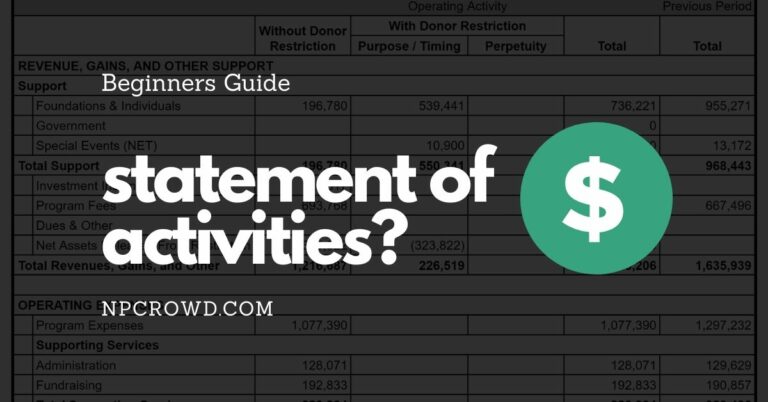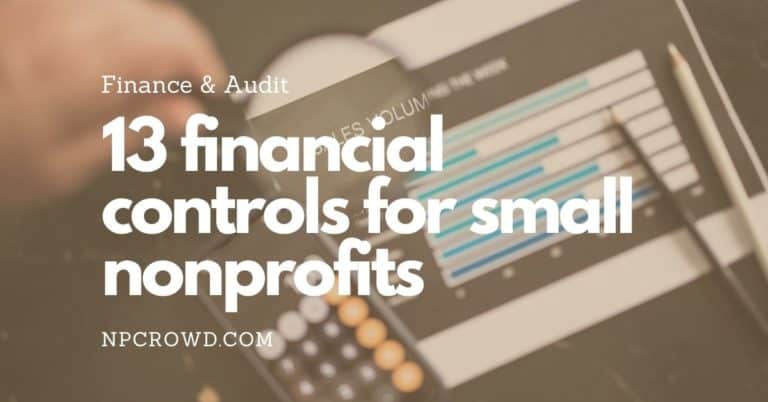Essential Nonprofit Strategic Planning FAQs Guide
Disclaimer: This post may contain affiliate links. These links, if used and purchases made, we may earn a small commission. These affiliate programs do not impact the recommendations we make or the resources we refer you to. Our focus is on providing you the best resources for your nonprofit journey.
Nonprofit strategic planning is a crucial process that can help organizations effectively navigate challenges and capitalize on opportunities. However, a significant number of nonprofits still lack a strategic plan, with 49% not having one in place. On the other hand, organizations that do have a strategic plan report numerous benefits, with 86% of respondents stating that it positively impacts revenue generation through grants, donors, events, and other avenues.In this comprehensive guide, we will answer common FAQs about nonprofit strategic planning, delve into the different types of strategic plans, provide a nonprofit strategic planning template, outline the steps involved in the strategic planning process, showcase several nonprofit strategic plan examples, and explore how donor management and fundraising software can support strategic planning efforts.
Key Takeaways:
- Nonprofit strategic planning is essential for organizations to navigate challenges and generate revenue.
- 49% of nonprofits do not have a strategic plan in place.
- Having a strategic plan positively impacts revenue generation through various avenues.
- This guide will address FAQs, provide templates, outline steps, and showcase examples of nonprofit strategic plans.
- Donor management and fundraising software can support strategic planning efforts.
What is strategic planning for nonprofits?
Strategic planning for nonprofits is a crucial process that involves creating a detailed blueprint to guide an organization towards achieving its goals over a specific period of time. It begins by reflecting on the organization’s mission and vision, identifying the most important goals, and defining the strategies that will be employed to accomplish those goals. A well-executed strategic plan ensures that the organization has clear pathways for success, aligns its resources effectively, and sets a direction for future growth and impact.
The Nonprofit Strategic Planning Process
The nonprofit strategic planning process consists of several key steps that organizations need to follow to develop a robust strategic plan. These steps include:
- Conducting a comprehensive assessment of the organization’s current state, including internal strengths and weaknesses, and external opportunities and threats
- Setting clear and measurable objectives based on the organization’s mission and priorities
- Identifying strategies and action plans to achieve the defined objectives
- Aligning resources, including human capital and financial investments, to support the strategic goals
- Establishing a monitoring and evaluation system to track progress and make necessary adjustments
By following a structured strategic planning process, nonprofits can ensure that their efforts are focused, impactful, and aligned with their overall mission and purpose.
Benefits of Nonprofit Strategic Planning
The strategic planning process offers numerous benefits to nonprofit organizations. These include:
- Alignment: A strategic plan aligns the board, staff, and stakeholders around a shared vision and goals, promoting unity and collaboration within the organization.
- Efficiency: By setting clear objectives and strategies, strategic planning streamlines decision-making processes, enabling quicker and more effective resource allocation.
- Sustainability: A well-executed strategic plan ensures the long-term sustainability of the organization by guiding its growth and development.
- Impact: Strategic planning enables nonprofits to maximize their impact by focusing on activities and initiatives that align with their mission and goals.
- Adaptability: Through regular monitoring and evaluation, strategic planning allows organizations to adapt to changing internal and external environments, ensuring continued relevance.
By leveraging the benefits of strategic planning, nonprofits can position themselves for success and create a greater positive impact on the communities they serve.

How often should nonprofits develop a strategic plan?
When it comes to nonprofit strategic planning, timing is crucial. Ideally, nonprofits should aim to develop a standard strategic plan every three to five years. This frequency allows sufficient time for the board and staff directors to review and realign goals, adapt to changes in the external environment, and update the organization’s strategic direction.
Developing a strategic plan within this timeframe provides nonprofits with the opportunity to assess their progress, reassess their goals, and make any necessary adjustments. It ensures that the organization remains focused and forward-thinking, enabling them to effectively navigate challenges and seize opportunities.
However, it’s essential to emphasize that strategic planning should not be a one-time event. Rather, it should be considered an ongoing process that requires regular review and adjustment. Internal and external factors can significantly impact an organization, and strategic planning helps nonprofits stay agile and responsive in the face of change.
Adapting to Change
Significant internal or external changes can warrant a reassessment of the strategic plan. These changes may include shifts in funding sources, new regulations, emerging technologies, or evolving community needs. Nonprofits should proactively monitor their operating environment to identify any shifts that may require a strategic pivot.
When a significant change occurs, nonprofits should evaluate their current strategic plan against the new realities and determine if adjustments are necessary. This ongoing evaluation and adjustment process ensures that the strategic plan remains relevant and effective in guiding the organization towards its goals.
Reacting to Internal Changes
Internal changes within the organization, such as a change in leadership, a merger, or a dramatic shift in the mission, can also trigger the need for strategic planning. These changes may require a fresh evaluation of the organization’s goals, strategies, and resources to ensure alignment and cohesiveness.
Regular check-ins with stakeholders, including board members, staff, volunteers, and community partners, can help identify any internal changes that may impact the strategic plan. By involving these key stakeholders in the planning process, nonprofits can ensure a holistic and inclusive approach that reflects the collective vision and values of the organization.
An Ongoing Journey
While a strategic plan every three to five years is a recommended frequency, strategic planning should not be a rigid or inflexible process. Nonprofits should embrace a mindset of continuous improvement and adaptability. This ongoing journey of strategic planning enables organizations to remain resilient and responsive in an ever-changing landscape, empowering them to achieve their mission and make a lasting impact.

| Frequency | Benefits |
|---|---|
| Every 3-5 years | – Review and realignment of goals – Adaptation to changes in the external environment – Updating the strategic direction |
| Ongoing | – Responsiveness to significant internal or external changes – Evaluation and adjustment of the strategic plan – Monitoring the operating environment |
Common Misconceptions About Nonprofit Strategic Planning
When it comes to nonprofit strategic planning, there are several common misconceptions that can hinder its effectiveness and limit an organization’s growth potential. It’s important to debunk these misconceptions and gain a clear understanding of the strategic planning process. Let’s explore some of the strategic planning myths and dispel them one by one:
-
Myth 1: Nonprofits should solely focus on saving or generating money.
This misconception suggests that nonprofits should prioritize financial preservation over strategic initiatives. However, investing in strategic purchasing decisions and effective spending can actually increase fundraising return on investment and position the organization for greater financial success. By strategically allocating resources and funds, nonprofits can enhance their impact and achieve long-term sustainability.
-
Myth 2: Taking risks is detrimental and should be avoided.
Some organizations fear taking risks, believing that it may lead to unpredictable outcomes and jeopardize their stability. However, calculated risks are essential for innovation and growth. By embracing calculated risks and establishing a culture of experimentation, nonprofits can explore new opportunities, adapt to changes, and drive transformative change within their sector.
-
Myth 3: Nonprofit boards are solely responsible for fundraising.
There is a common misconception that the sole responsibility of fundraising falls on the shoulders of volunteer boards. In reality, the board’s primary role is to provide oversight and strategic direction. To maximize fundraising outcomes, staff members and other stakeholders should also actively participate in fundraising efforts. Collaboration and shared responsibility among all stakeholders can lead to more successful and sustainable fundraising initiatives.

By understanding and debunking these misconceptions, nonprofits can take a more holistic approach to strategic planning. Embracing strategic initiatives, embracing calculated risks, and involving all relevant stakeholders in fundraising efforts can lead to effective and impactful strategic planning outcomes.
How to Begin the Nonprofit Strategic Planning Process
Starting nonprofit strategic planning is an important step towards achieving your organization’s goals and making a positive impact in your community. To begin this process, follow these essential steps:
- Identify Measurable Objectives: Start by having discussions with key stakeholders to identify clear and measurable objectives that align with your mission and vision. These objectives should be specific, achievable, and time-bound.
- Draft Priorities: Once you have identified your objectives, draft a list of priorities for each objective. This will help you determine the most critical areas to focus on during the strategic planning process.
- Conduct a SWOT Analysis: Perform a SWOT analysis to assess your organization’s strengths, weaknesses, opportunities, and threats. This analysis will provide valuable insights into your internal and external environment, helping you understand your organization’s current position and potential areas for improvement.
- Select an Appropriate Strategic Planning Model: Use the insights gained from the SWOT analysis to select a strategic planning model that best suits your organization’s needs. Popular models include the balanced scorecard, SMART goals, or OKRs (Objectives and Key Results).
By following these steps, you can lay a solid foundation for your nonprofit strategic planning process. Remember, strategic planning is an ongoing journey, and regular review and adjustment are necessary to ensure its effectiveness.
| Step | Description |
|---|---|
| 1 | Identify Measurable Objectives |
| 2 | Draft Priorities |
| 3 | Conduct a SWOT Analysis |
| 4 | Select an Appropriate Strategic Planning Model |
Types of Nonprofit Strategic Plans
Nonprofit organizations have various options when it comes to choosing strategic plans that align with their unique circumstances, opportunities, and threats. Understanding the different strategic planning models allows nonprofits to select the most suitable approach for their specific needs and goals.
The standard strategic planning model is the most commonly used and is appropriate for organizations operating in a relatively stable external environment. This model involves setting clear objectives, defining strategies to achieve those objectives, and implementing action plans.
For nonprofits facing more turbulent internal operations, the issues-based strategic planning model may be a better fit. This model focuses on addressing specific challenges or opportunities identified within the organization and developing strategies to overcome them.
When there are uncertain external factors that require adaptability and responsiveness, nonprofits can opt for the organic and real-time strategic planning models. The organic model emphasizes continuous learning, agility, and flexibility, allowing the organization to adjust its strategies as needed. The real-time model involves ongoing monitoring of the external environment and adapting strategies in real-time to maximize opportunities and mitigate threats.
To illustrate the differences between these strategic planning models, the table below provides a comparison based on key characteristics:
| Strategic Planning Model | Key Characteristics |
|---|---|
| Standard | Designed for stable external environments |
| Issues-Based | Focuses on specific challenges or opportunities |
| Organic | Emphasizes continuous learning and adaptability |
| Real-Time | Involves ongoing monitoring and real-time adaptation |
By considering the unique context of their organization and its environment, nonprofits can select a strategic planning model that best suits their goals and objectives. The chosen model will provide a framework for developing and implementing a comprehensive strategic plan that propels the organization towards success.
The Benefits of Nonprofit Strategic Planning
Nonprofit strategic planning offers a range of benefits for organizations. By investing in strategic planning, nonprofits can position themselves for long-term success and maximize their positive impact on the communities they serve. Here are some key advantages of strategic planning for nonprofits:
- Aligning the board and staff: Strategic planning helps align the board and staff around a shared vision, ensuring that everyone is working towards the same goals and objectives.
- Fostering consensus and buy-in: By involving key stakeholders in the strategic planning process, nonprofits can foster consensus and buy-in, increasing the likelihood of successful plan implementation.
- Saving time: Strategic planning streamlines decision-making processes, saving time by providing a clear roadmap for organizational priorities.
- Guiding resource allocation: A strategic plan guides resource allocation and spending, ensuring that limited resources are used in the most effective and efficient way.
- Increasing staff motivation and engagement: When staff members are involved in the strategic planning process, they feel a sense of ownership and are more motivated and engaged in their work.
- Enhancing impact and sustainability: Strategic planning helps nonprofits focus on their mission and goals, enhancing their impact on the communities they serve and ensuring long-term sustainability.
- Improving fundraising outcomes: A strategic plan provides a clear and compelling vision for donors, improving fundraising outcomes and attracting support for the organization’s mission.
By leveraging the benefits of nonprofit strategic planning, organizations can set themselves up for success and achieve long-term sustainability. The advantages of strategic planning for nonprofits extend beyond organizational growth, positively impacting staff, stakeholders, and the communities they serve.
Conclusion
Nonprofit strategic planning is a vital process that can unlock your organization’s growth potential and enhance its ability to achieve its mission. By understanding the fundamentals of strategic planning, dispelling common misconceptions, and implementing best practices, you can develop a robust and effective strategic plan.
Start by leveraging strategic planning models that align with your organization’s needs. Engage key stakeholders throughout the process to ensure their input and buy-in. Regularly review and revise your plan to stay adaptable in the face of change. And don’t forget to utilize technology tools that can streamline and enhance your strategic planning efforts.
With a well-crafted strategic plan in place, your nonprofit can confidently navigate change, seize opportunities, and thrive in today’s dynamic and competitive nonprofit landscape. Follow these tips and best practices outlined in this guide to create a roadmap for success and maximize your organization’s positive impact on the communities you serve.
FAQ
What is nonprofit strategic planning?
Nonprofit strategic planning refers to the process of creating a detailed blueprint that guides an organization for a specific period of time and helps accomplish its goals. It involves reflecting on the organization’s mission, identifying the most important goals, and determining the strategies that will be used to achieve those goals.
How often should nonprofits develop a strategic plan?
Ideally, nonprofits should develop a standard strategic plan every three to five years. This timeframe allows the board and staff directors to review and realign goals, adapt to changes in the external environment, and update the organization’s strategic direction. However, it’s important to note that strategic planning is an ongoing process and should be revisited and adjusted as needed, particularly in response to significant internal or external changes.
What are some common misconceptions about nonprofit strategic planning?
One common misconception is the belief that a nonprofit should focus solely on saving or generating money, rather than investing in strategic initiatives. However, strategic purchasing decisions and effective spending can actually increase fundraising return on investment and position the organization for greater financial success. Another misconception is the fear of taking risks. In reality, calculated risks are necessary for innovation and growth. Lastly, some nonprofits believe that their volunteer boards should be solely responsible for fundraising. In truth, the board’s role is to provide oversight and strategic direction, while staff and other stakeholders should be involved in fundraising efforts.
How do you begin the nonprofit strategic planning process?
The nonprofit strategic planning process typically begins with discussions to identify measurable objectives, draft priorities for each objective, and conduct a SWOT (strengths, weaknesses, opportunities, threats) analysis. This analysis helps clarify goals and informs the selection of an appropriate strategic planning model. The chosen model will guide the organization in charting its strategic course and ensuring alignment with its mission and goals.
What are the different types of nonprofit strategic plans?
Nonprofit organizations may choose from different types of strategic plans based on their specific circumstances, opportunities, and threats. The standard strategic planning model is the most common and is suitable when the organization operates in a relatively stable external environment. Other models include the issues-based strategic planning model, which is useful when internal operations are more turbulent, and the organic and real-time strategic planning models, which are suitable when there are uncertain external factors that require adaptability and responsiveness.
What are the benefits of nonprofit strategic planning?
Nonprofit strategic planning offers a range of benefits for organizations. It helps align the board and staff around a shared vision, fosters consensus and buy-in, saves time by streamlining decision-making processes, guides resource allocation and spending, increases staff motivation and engagement, enhances the organization’s impact and sustainability, and improves fundraising outcomes by providing a clear and compelling vision for donors. By investing in strategic planning, nonprofits can position themselves for long-term success and maximize their positive impact on the communities they serve.
What is the conclusion for nonprofit strategic planning?
Nonprofit strategic planning is a vital process that can unlock an organization’s growth potential and enhance its ability to achieve its mission. By understanding the fundamentals of strategic planning, dispelling common misconceptions, and implementing best practices, nonprofits can develop robust and effective strategic plans. Leveraging strategic planning models, engaging key stakeholders, regularly reviewing and revising the plan, and utilizing technology tools can all contribute to a successful strategic planning process. With a well-crafted strategic plan in place, nonprofits can navigate change, seize opportunities, and thrive in today’s dynamic and competitive nonprofit landscape.







